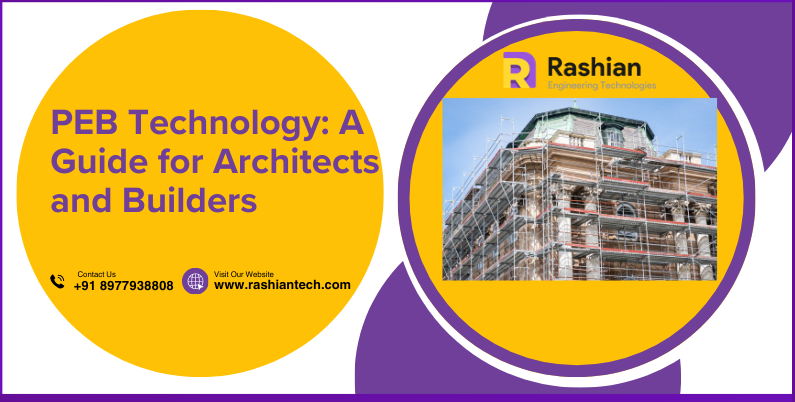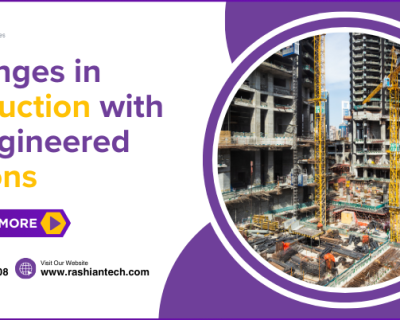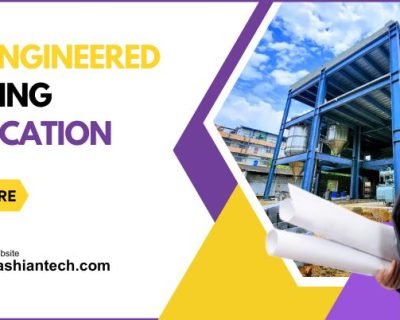Blog

PEB Technology: A Guide for Architects and Builders at Rashian Engineering
PEB Technology: A Guide for Architects and Builders at Rashian Engineering. The construction industry is continuously evolving, with innovative techniques and materials shaping the way buildings are designed and constructed. One of the most transformative developments in recent years is the rise of Pre-Engineered Building (PEB) technology. This modern construction methodology offers numerous advantages, including cost-efficiency, speed, flexibility, and sustainability. Rashian Engineering, a leader in this field, has been at the forefront of implementing PEB technology in various projects. In this blog, we’ll explore what PEB technology is, how it works, and why it is a game-changer for architects and builders.
What is PEB Technology ,Guide for Architects and Builders at Rashian Engineering
Pre-Engineered Buildings (PEB) are structures that are designed and fabricated in a factory, typically in sections, before being transported to the construction site for assembly. Unlike conventional building methods, where construction materials are typically sourced on-site and assembled in a piecemeal fashion, PEBs are prefabricated in a controlled environment, ensuring higher quality, faster construction times, and reduced labor costs.
The PEB system incorporates steel, metal, and other materials, which are carefully engineered to suit the specific requirements of each project. These buildings are predominantly used for industrial, commercial, and warehouse structures, but can also be adapted for residential purposes. The technology allows for a high degree of customization, offering flexibility in design while maintaining structural integrity and performance.
The Components of PEB Technology
PEB technology relies on several key components, which are fabricated in a factory before being shipped to the construction site. These components include steel columns, beams, purlins, girts, roofing systems, and wall panels. All these elements are precisely engineered and manufactured to meet the specifications of the particular project.
Steel, which is the most common material used in PEB construction, offers strength, durability, and flexibility. Structural elements are designed to handle specific loads and are assembled into a modular system that can be adapted for different types of buildings. The pre-engineered structure is then transported to the site where it is assembled using bolted connections, making the entire construction process faster and more efficient.
Advantages of PEB Technology for Architects and Builders
Cost Efficiency
One of the main reasons why PEB technology has gained popularity in the construction industry is its cost-effectiveness. Since components are manufactured in a factory, economies of scale come into play, reducing material waste and overall costs. Moreover, the prefabrication process eliminates the need for expensive on-site labor and minimizes delays caused by weather conditions or logistical issues. Builders can therefore complete projects faster, saving both time and money.
Speed of Construction
Traditional construction methods can be time-consuming due to the on-site assembly and material sourcing processes. PEB technology, on the other hand, streamlines this by reducing the construction timeline significantly. Components are pre-engineered and ready for assembly upon delivery, which means construction time can be reduced by 30% or more. For builders, this speed translates to faster project turnaround and increased revenue potential. For architects, it provides the ability to deliver projects on tight schedules, enhancing client satisfaction.
Quality Control
Quality control is another significant advantage of PEB technology. Since the majority of the fabrication occurs in a controlled factory environment, the materials and components are manufactured with a high degree of precision. This reduces the chances of defects and inconsistencies, ensuring that the final structure is built to the highest standards. Moreover, the standardized production processes mean that each component is designed to fit perfectly with the others, reducing the likelihood of errors during assembly on-site.
Design Flexibility
PEB technology offers architects a high level of design flexibility. Despite being pre-engineered, these buildings can be customized to meet the specific aesthetic, functional, and spatial requirements of a project. Architects can specify everything from the height and width of the structure to the type of roofing, insulation, and cladding materials. This flexibility allows PEBs to be adapted for various building types, including factories, warehouses, office buildings, sports facilities, and even residential properties.
Sustainability
The sustainability aspect of PEB technology is becoming increasingly important in today’s construction landscape. PEBs are made from recyclable steel, which is an environmentally friendly material. Additionally, the prefabrication process reduces waste significantly, as components are manufactured to exact specifications with minimal excess materials. The energy-efficient insulation systems used in PEB construction also contribute to a building’s overall sustainability, reducing the need for heating and cooling, and thereby lowering energy consumption over time.
Strength and Durability
PEBs are known for their strength and durability. The steel frames used in these buildings provide exceptional load-bearing capacity, allowing them to withstand harsh weather conditions, including high winds and heavy snow loads. This makes PEB technology an excellent choice for structures located in regions prone to extreme weather events. The longevity of steel also ensures that PEB buildings require minimal maintenance over the years, further reducing long-term costs for property owners.
Minimal Site Disruption
Traditional construction methods can cause significant disruption to the site, particularly in urban areas where space is limited. With PEB technology, the construction process is less intrusive. Since most of the work is done off-site, there is less need for heavy machinery, excavation, and on-site labor. This leads to a cleaner, safer, and more efficient construction process, with minimal disruption to the surrounding environment or neighboring properties.
Rashian Engineering and PEB Technology
Rashian Engineering has earned a reputation for its expertise in PEB technology, offering a range of services that cater to architects, builders, and developers. The company has been instrumental in driving the adoption of PEB solutions in a variety of sectors, including industrial, commercial, and residential construction. With a focus on quality, innovation, and customer satisfaction, Rashian Engineering has become a trusted partner for those looking to incorporate PEB technology into their projects.
At Rashian Engineering, PEB structures are designed using the latest software tools, ensuring that each building is not only structurally sound but also optimized for energy efficiency and sustainability. Their team of engineers, architects, and project managers work closely with clients to develop customized solutions that meet specific project needs. Whether it’s a large-scale warehouse, an office building, or a complex industrial facility, Rashian Engineering’s PEB technology provides an efficient, cost-effective, and reliable solution.
The company’s commitment to quality and safety is evident in their rigorous quality assurance processes. All components are thoroughly tested and inspected before being shipped to the construction site. Additionally, the company offers after-sales services, including maintenance and support, ensuring that the building continues to perform optimally long after the project is completed.
The Role of Architects in PEB Construction
For architects, the integration of PEB technology into a project requires a shift in thinking and approach. Unlike traditional construction, which often involves designing on-site assembly methods, PEB design is a more systematic process that requires a deeper understanding of factory processes and material behavior. Architects need to work closely with engineers to ensure that the design is compatible with the PEB system.
However, PEB technology also presents exciting opportunities for architects. The high degree of flexibility offered by PEB systems allows for innovative designs that may not be feasible with traditional construction methods. Additionally, the faster construction timelines enable architects to bring their designs to life more quickly, meeting tight deadlines and reducing the time clients have to wait before occupying a building.
Architects also need to consider the sustainability of the project, and PEB technology aligns well with green building standards. With its focus on energy efficiency, reduced waste, and the use of recyclable materials, PEB construction offers architects the chance to design buildings that are not only functional and aesthetically pleasing but also environmentally responsible.
The Future of PEB Technology
As the construction industry continues to evolve, the role of PEB technology is expected to expand. Advancements in software, materials science, and manufacturing techniques are likely to make PEBs even more versatile and cost-effective in the future. Moreover, with increasing pressure to reduce carbon footprints and promote sustainability, the demand for energy-efficient, low-waste building solutions like PEBs is expected to grow.
Rashian Engineering is well-positioned to lead the way in this transformation, offering cutting-edge PEB solutions that meet the needs of modern construction. The future of PEB technology holds exciting possibilities for architects and builders alike, as they embrace new methods and materials that revolutionize the way buildings are designed, constructed, and utilized.
Conclusion
PEB technology represents a major leap forward in the construction industry, offering numerous benefits to architects, builders, and property owners alike. The ability to reduce costs, speed up construction timelines, and improve quality makes PEBs an attractive choice for a wide range of building projects. As leaders in the field, Rashian Engineering continues to push the boundaries of what is possible with PEB technology, providing innovative, sustainable, and efficient solutions for clients across various sectors.
For architects and builders looking to stay ahead of the curve, embracing PEB technology is not just an option—it’s a strategic decision that will shape the future of construction. By understanding the principles of PEB technology and leveraging the expertise of companies like Rashian Engineering, professionals can unlock a world of possibilities and create structures that are not only functional and beautiful but also sustainable and cost-effective.





13 comments on “PEB Technology: A Guide for Architects and Builders at Rashian Engineering”
Comments are closed